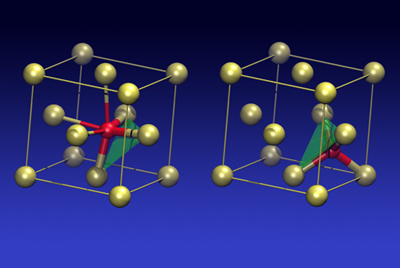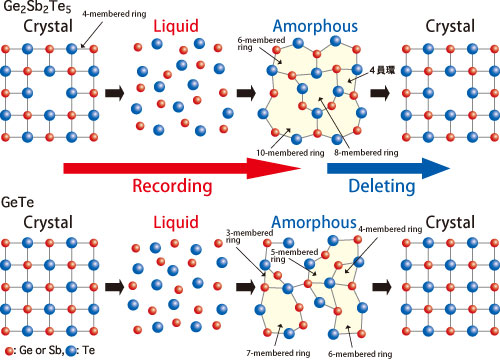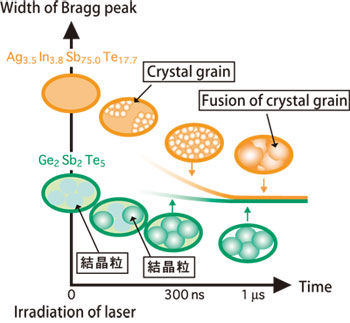Topic 13: Unraveling Structural Mechanisms of High-Speed Optical Recording on DVD Materials
Ultrafast Transition in a Crystal Structure - Secret of Nanosecond Optical Recording
DVD-RAM, a rewritable optical disc, is a common recording media for video, music, and computer data. Surprisingly, the mechanisms enabling high-speed writing, reading, deleting, and rewriting were unknown. Although it is known that the atomic bonding state of materials comprising thin-film memory layers on disc surfaces is repeatedly altered between transition and recovery according to the intensity of the irradiated light, the process of such changes could not be determined because a technique did not exist to observe ultrafast changes in atomic bonding on the nanosecond (1 nanosecond = 10-9 sec) level. Fortunately, the synchrotron radiation at SPring-8 overcame this difficulty, and research has revealed the underlying mechanisms.
Principle of DVDs and the Mystery of their Mechanisms
Thin-film memory layers on the surfaces of unused DVD-RAM are composed of regularly arranged composite crystals such as Ge2Sb2Te5 (germanium antimony telluride), which are comprised of multiple metal atoms. Instantaneously irradiating such crystals with intense laser light liquefies the irradiated parts for a split second, but these parts are quickly cooled by room temperature, yielding an amorphous phase where atomic bonding is distorted and hardened. Re-irradiating the thin-film layers in such a state with weak laser light causes the light reflectance of the crystal phase to differ from that of the amorphous phase. Herein, “write” and “read” of digital data become possible by creating a crystal phase for “0” and an amorphous phase for “1.” To delete old data and rewrite new data, the intensity of irradiated light must be stronger than that for reading and must be adjusted so as not to melt the amorphous phase but allows the phase to recrystallize.
Although this is the principle of DVD-RAM, (1) the structures of the crystal or the amorphous phase were not elucidated. Furthermore, (2) the processes of inducing the phase transition and reverse-phase transition between the crystal and amorphous phases upon irradiating with laser light were unknown and (3) the mechanisms of such ultrafast phase transitions, which occur on the order of nanoseconds, remained mysteries. “You might not believe it, but these facts were true. Thus, I was totally engrossed in unraveling this mystery by any means,” mentions Dr. Masaki Takata (Chief Scientist, RIKEN, Japan) to explain the motivation behind his studies.
Restoring the Original State of DVD is Similar to an Umbrella
Dr. Junji Tominaga (Director, The Center for Applied Near-Field Optic Research, National Institute of Advance Industrial Science and Technology, Japan), Dr. Alexander Kolobov (Chief Researcher, ditto), Dr. Paul Fons (Staff Researcher, ditto), and colleagues are the ones who initiated research to unravel the mysteries of DVDs. In 2004, their research group answered a longstanding question when they revealed the underlying mechanisms for the ultrafast writing/deleting processes of DVDs by thoroughly examining the crystal and amorphous structures of Ge2Sb2Te5 using a combination of synchrotron radiation at SPring-8 and an X-ray absorption fine structure (XAFS) technique. When an object is irradiated with X-rays, the atoms in the object absorb X-rays and emit photoelectrons. Because the wave of this photoelectron is reflected from neighboring atoms and the waves interfere with each other, characteristic oscillations appear in the X-ray absorption spectrum. The XAFS technique analyzes these oscillations to determine the distance between a specific atom and its neighboring atoms as well as to examine the interactions between these atoms.
Dr. Tominaga and colleague's analysis revealed that the transition of Ge2Sb2Te5 from the crystal phase to the amorphous phase maintains the reversible basic bonding relationship between atoms. This phenomenon is analogous to an umbrella that is turned inside out due to a strong wind, but instantaneously recovers its original shape. Herein, pivotal germanium atoms shift to a different bonding state at a high speed, which induces an instantaneous and reversible phase transition (Fig. 1). Hence, the amorphous phase of Ge2Sb2Te5 differs from the normal amorphous phase where atoms are randomly situated and this shift does not occur. Thus, energy and time required in this phase transition are small. This breakthrough discovery was published in Nature Materials (October 2004).

Movement of a germanium atom (red) through a plane (green) induces a phase transition.
Directly Observing Ultrafast Phase Transition Processes for the First Time
As mentioned above, the mechanisms enabling a phase transition of Ge2Sb2Te5, which occurs at a speed on the 20 nanosecond level, were revealed. However, a detailed study on the state changes of the atomic bonding in an ultrafast phase transition had not been performed. Dr. Takata, Dr. Noboru Yamada (Researcher, Panasonic Corp., Japan), Dr. Shinji Kohara (Associate Senior Scientist, the Japan Synchrotron Radiation Research Institute (JASRI)), and colleagues undertook the “X-ray pinpoint structural measurement of reaction phenomena” project to investigate the effects of the structural differences on the phase transition speed. Their research group conducted experiments at the High Energy X-ray Diffraction Beamline (BL04B2) and at the Powder Diffraction Beamline (BL02B2) at SPring-8 to compare the atomic structure of Ge2Sb2Te5 and that of germanium telluride (GeTe), which has a slower phase transition speed on the 100-nanosecond level, in the crystal, liquid, and amorphous phases. Their analysis of the diffraction data yielded a breakthrough.
The basic structural component in the crystal phase is a 4-membered ring (four atoms are connected in square shape) in both Ge2Sb2Te5 and GeTe. Upon irradiating with laser light, these two materials are converted into the amorphous phase via transient liquefaction. Ge2Sb2Te5 is converted into aggregates composed of rings with an even number of atoms (4, 6, 8, and 10 atoms), whereas GeTe is converted into rings with an odd or even number of atoms (3, 4, 5, 6, and 7 atoms). When they return to the crystal phase, Ge2Sb2Te5, which consists solely of even-numbered rings, easily regains the original structure containing only 4-membered rings with minimal recombinations, whereas GeTe, which is comprised of mainly odd-numbered rings, requires a complicated recombination to recover only the 4-membered ring structure (Fig. 2). Hence, their study revealed the origin of the differences in the phase transition speeds between these two materials (especially those from the amorphous phase to the crystal phase), and their results were reported at the International Symposium on Optical Memory (October, 2006).
In 2008, Dr. Shigeru Kimura (Associate Chief Scientist, JASRI), Dr. Yoshihito Tanaka (Senior Scientist, RIKEN), and colleagues, who are affiliated with above project group, observed the first real-time ultrafast transition processes from the amorphous phase to the crystal phase (data deletion processes) of Ge2Sb2Te5 and Ag3.5In3.8Sb75.0Te17.7 (silver-indium-antimony-tellurium quaternary compound), which are representative raw materials of optical discs. Using synchrotron radiation at SPring-8, which is pulsed X-rays with a 40-picosecond duration (1 picosecond = 10-12 sec), a phase transition can be observed using time-resolved X-ray diffraction by synchronizing an irradiated laser light pulse onto an amorphous solid with an X-ray pulse at the picosecond level. To this end, an X-ray pinpoint structural measurement system, which is capable of recording X-ray diffraction data and optical reflectance variation data at a time resolution of 40-picoseconds, was installed in the High Flux Beamline BL40XU at SPring-8.
This system revealed that in Ge2Sb2Te5 comparatively large crystal grains are initially created. These grains then multiply until the entire body is filled with them. This process differs from that for Ag3.5In3.8Sb75.0Te17.7 in which many tiny crystal grains are initially created. These small grains combine to form larger crystal grains, and eventually yield the final crystal structure (Fig. 3). Moreover, the data deletion processes and phase transitions in both materials occur at the same nanosecond level. These results were published in the online edition of Applied Physics Express (March 2008). “I would like to apply the outcomes obtained from these studies toward realizing the ‘dream of directly measuring electrons' using pulsed X-rays on the order of a femtosecond (femto = 10-15) duration,” Dr. Takata explains about his future research plans.

Fig. 2. Phase transition model of Ge2Sb2Te5 and GeTe.

Fig. 3. Phase transition model of the raw materials of Ge2Sb2Te5 and Ag3.5In3.8Sb75.0Te17.7 in the data deletion processes.
References
1.A. V. Kolobov, P. Fons, A. I. Frenkel, A. L. Ankudinov, J. Tominaga and T. Uruga; Nature Materials, 3, 703 (2004)
2. S. Kohara, K. Kato, S. Kimura, Hitoshi Tanaka, T. Usuki, K. Suzuya, Hiroshi Tanaka, Y. Moritomo, T. Matsunaga, N. Yamada, Y. Tanaka, H. Suematsu and M. Takata; Appl. Phys. Lett., 89, 201910 (2006)
3. Y. Fukuyama, N. Yasuda, J. Kim, H. Murayama, Y. Tanaka, S. Kimura, K. Kato, S. Kohara, Y. Moritomo, T. Matsunaga, R. Kojima, N. Yamada, H. Tanaka, T. Ohshima and M. Takata; Appl. Phys. Express, 1, 045001 (2008)